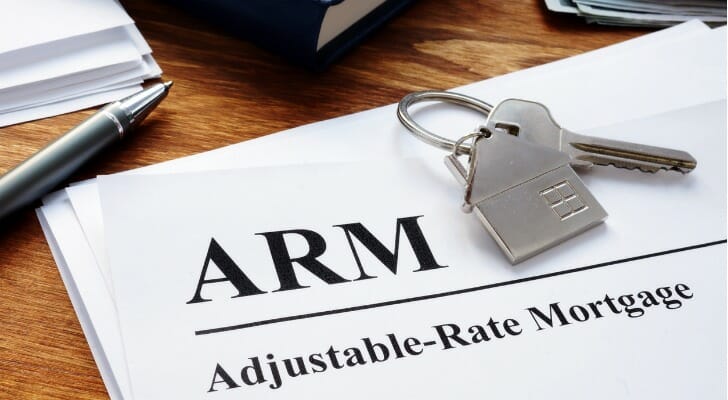Loan products such as 5/1 adjustable rate mortgages give borrowers reduced interest rates for five years, giving homeowners some much-needed breathing room. This can help, especially as mortgage rates have been on the rise. During the loan’s first five years, homeowners have the opportunity to save money on their mortgage payments and wait for the market to calm down. However, after five years the payment amount will take a substantial leap, costing those who don’t refinance more money. If you’re thinking about using a 5/1 arm for your next home purchase then you may want to speak to a financial advisor first to help you determine if it’s the right choice.
What Is a 5/1 Adjustable Rate Mortgage (ARM)?
A 5/1 adjustable rate mortgage (ARM) is a mortgage loan with an initially low-interest rate lasting five years. Once the five years expire, the interest rate changes based on the interest rates on various lending market indexes.
As you might have been able to tell, the five in 5/1 stands for the number of years you receive the initial interest rate. The second number represents how often your interest rate adjusts in subsequent years. With a 5/1 ARM, the interest rate will shift once annually.
What Index Does a 5/1 Adjustable Rate Mortgage (ARM) Follow?
The market index your ARM follows influences your interest rate after the five-year period expires. A 5/1 ARM may follow one of the following indexes: the 11th district cost of funds index (COFI), the Secured Overnight Financing Rate (SOFR) or the yield on 1-year Treasury bills.
ARM interest rates adjust based on the market index rate plus margin, which increases the interest rate to help your lender make money on its products and services. For example, let’s say the SOFR governs your interest rate and is currently 1.5%. Your lender’s margin is 1.5% as well, so your interest rate would be 3%.
Advantages Of Using a 5/1 ARM

A 5/1 ARM has many benefits that could give you what you’re looking for in a short-term loan for your home. It might be the right mortgage for you if you’re looking for the following perks:
- Timeframe for a sale or refinance: Borrowers planning on selling or refinancing their home before five years expire will benefit from a 5/1 ARM. They can avoid the adjustable rate and maximize their savings by only paying the lower initial payments.
- Less expensive payments, initially: The initial rate from the 5/1 ARM can lower your mortgage payments compared to fixed-rate mortgages. In addition, if your market index rate stays low, you could experience further savings after your loan adjusts. Plus, if the interest rate increases, your ARM cap structure can help keep the rate at a manageable level.
- Spend less on interest: A low, fixed rate for five years will allow you to pay less interest. You can use your savings to target the principal of the loan, reducing your future monthly payment and the total interest paid on the loan. With sustained payments on the principal during the first five years, you could save thousands of dollars over the next few decades of paying your mortgage.
- Bigger home: Your low initial monthly payment could help you afford a bigger house for your family. However, remember that your payment could significantly increase after five years if you don’t refinance within that time period. That means that it is a financial risk that could come back to haunt you if you’re stretching your wallet to pay for the loan.
Disadvantages Of Using a 5/1 ARM
While a 5/1 ARM brings substantial advantages, it’s vital to keep the following drawbacks in mind before making a final decision:
- Potential for high interest: After five years, the adjustment could raise your interest rate to the maximum percentage allowed. For example, your interest rate could grow from 2.5% to 5% with the first adjustment. Therefore, it’s crucial to calculate if you can afford the highest possible payments on your mortgage before signing a 5/1 ARM. Otherwise, an interest rate hike could put you in dire straits financially.
- Negligible rate difference: Some fixed-rate mortgages have excellent interest rates, and the 5/1 ARMs available to you might have a barely better interest rate for the first five years. After that, the unpredictable interest rate might be higher than a fixed-rate mortgage. On the other hand, a fixed-rate mortgage offers one consistent monthly payment over the life of the loan, saving you the hassle and possibly some cash.
- Convoluted loan details: Cap structures, adjustable rates, market indexes – ARMs come with a lot of industry jargon that can turn off borrowers or leave them feeling confused about their loan. Conversely, fixed-rate loans are more straightforward and predictable, which can relieve stress and simplify the situation.
- Interest-only stipulations: Some ARMs prevent borrowers from paying the principal at all during the fixed-rate period. This requirement could leave you with a financial millstone, specifically if your interest rate skyrockets after five years. Since you cannot pay down the principal, a higher interest rate could raise your monthly payment to an unaffordable level.
What Should You Look For When Comparing a 5/1 ARM?
5/1 ARMs have several components that vary by loan or lender. When shopping for a 5/1 ARM, keep an eye out for how the following features differ:
- Fixed-rate period: Sometimes called a teaser rate, the fixed-rate period defines how long you’ll pay the low introductory interest rate. 5/1 ARMs have a fixed rate for five years.
- Adjustment pace: The second number in the name, a 5/1 ARM adjusts once per year after the fixed-rate period expires. You might find 5/6 ARMs in your search, which adjust the interest rate every six months after your fixed rate ends.
- Initial cap: ARMs have cap structures comprised of three figures. For example, a cap structure of 2/1/5 has an initial cap of two. This number means that after the teaser rate, the first adjustment to the interest rate cannot exceed 2% more than the initial rate.
- Cap on further adjustments: Continuing with the example, the middle number is one and caps adjustments follow the first change. This cap prevents the interest rate from shifting by more than 1%.
- Lifetime cap: The last number in the example is five, meaning over the life of the loan, your interest rate cannot be more than five percentage points higher than your initial interest rate. The lifetime cap helps keep your interest rate under control even if interest rates spike.
Is a 5/1 ARM Right for You?
A 5/1 ARM can help you secure a low fixed interest rate for five years. During this period, your reduced monthly payment can provide extra funds for any financial needs or goals, such as repairing the home, aggressively paying down the loan principal or repaying other debts. Additionally, if you plan on selling the home or refinancing before the teaser rate expires, you could entirely avoid the variable interest rate.
A 5/1 arm is also an interesting prospect for those that feel confident in their ability to refinance within five years based on their financial history and job security. This could give you extra income to invest and the amount that you’ll make off of those investments could be substantial over a 4 – 5 year period.
However, a 5/1 ARM might not be for you if you’re looking for a steady interest rate over the life of a long-term loan. Additionally, if you want to stay in your home for the next couple of decades, you might experience high-interest rates further down the line, nullifying the savings you racked up earlier. This, of course, is only if you’re unable to refinance. The future can be unpredictable so it’s a risk that some may not be able to afford.
5/1 ARM vs. 7/1 ARM
Similarly, a 5/1 ARM has a lower initial rate than a 7/1 ARM. However, a 7/1 ARM gives the borrower two additional years of a lower fixed rate, which can be particularly beneficial if you’re planning on selling your home within seven years to interest rate hikes. A 5/1 ARM can provide a similar benefit to a homeowner planning on selling or refinancing within five years of buying their house.
5/1 ARM vs. 10/1 ARM
A 5/1 and a 10/1 ARM have a lot in common. For example, they both adjust once per year after the low fixed-rate period. However, as the name implies, a 10/1 ARM adjusts after ten years instead of five. Since a 5/1 ARM has a shorter fixed rate term, it has a lower interest rate than a 10/1 ARM during the initial loan period.
The Bottom Line

A 5/1 ARM can help you save money on your mortgage payments through a low fixed interest rate for the first five years of the loan. Your small mortgage payment can help you afford a larger home or address other financial needs during the teaser period. Additionally, selling or refinancing before your rate adjusts can help you take full advantage of the loan without suffering from a higher interest rate.
However, homeowners can get bogged down with the details of 5/1 ARMs, meaning it’s a good idea to do your homework before committing to one. Additionally, a fixed-rate mortgage might be better for you if you want to stay in your home for more than five years or don’t want to deal with a variable interest rate.
Tips for 5/1 Adjustable Rate Mortgages
- Purchasing a home is one of the most crucial investments you’ll ever make, and how you finance your house can have significant financial ramifications. Therefore, guidance from a qualified financial advisor can be essential for you and your family during this process. SmartAsset’s free tool matches you with up to three financial advisors who serve your area, and you can interview your advisor matches at no cost to decide which one is right for you. If you’re ready to find an advisor who can help you achieve your financial goals, get started now.
- If you’re stuck between choosing different mortgages, your interest rate might be the deciding factor. Use a mortgage calculator to see how much you can afford.
- House hunting starts with a mortgage preapproval, no matter what mortgage you choose. Preapproval requires extensive documentation and research. So, it always pays to have a mortgage preapproval checklist by your side.
©iStock.com/designer491, ©iStock.com/xijian, ©iStock.com/David Gyung
